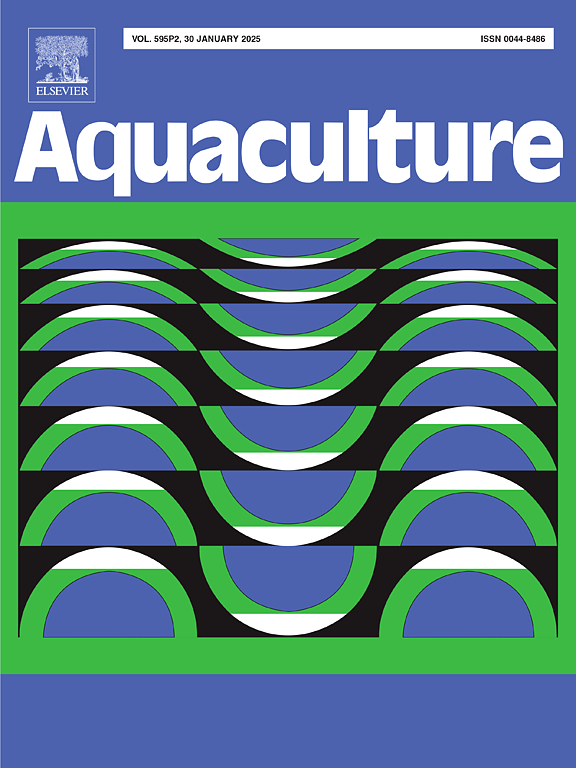一种新的具有抗菌免疫功能的海参WAP结构域蛋白的鉴定
IF 3.9
1区 农林科学
Q1 FISHERIES
引用次数: 0
摘要
在许多物种中,乳清酸性蛋白结构域蛋白(WD蛋白)是先天免疫系统中的重要分子。本研究从日本Apostichopus japonicus中克隆了一种新的WD蛋白(AjSWD),并对其抑菌功能和机制进行了进一步研究。AjSWD蛋白含有1个WAP结构域(10-55 aa)和1个KAZAL结构域(99-147 aa)。所有组织中均检测到AjSWD mRNA,其中体壁表达量最高,其他组织表达量较低。脾弧菌攻毒后,体腔细胞和体壁组织中AjSWD mRNA和蛋白的表达显著升高。抑菌功能研究中,重组AjSWD及其WAP结构域(AjSWD-WAP)均表现出明显的细菌凝集、PAMPs结合活性和抗菌活性。然后确定rAjSWD和rAjSWD- wap的抗菌机制为破坏细菌细胞膜。此外,rAjSWD和rAjSWD- wap均能有效提高黄颡鱼攻毒后幼鱼的存活率。此外,与rAjSWD相比,rAjSWD- wap具有更高的抗菌效果。综上所述,本研究提示rAjSWD和rAjSWD- wap具有显著的抗菌性能,且AjSWD基因在海参的先天免疫中起重要作用。本文章由计算机程序翻译,如有差异,请以英文原文为准。
Characterization of a novel WAP domain-containing protein with antibacterial immunity from sea cucumber Apostichopus japonicus
In various species, Whey acidic protein domain-containing proteins (WD proteins) are important molecules in the innate immune systems. In this study, a novel WD protein (AjSWD) was cloned from Apostichopus japonicus, its antibacterial function and mechanism were further studied. The AjSWD protein contained one WAP domain (10–55 aa) and one KAZAL domain (99–147 aa). AjSWD mRNA was detected in all chosen tissues, with highest expression level found in the body wall and lower expression level in other detected tissues. Then following the challenge of Vibrio splendidus, we found AjSWD mRNA and protein expression in coelomocytes and body wall tissues increased to significantly high levels. On antibacterial function research, recombinant AjSWD and its WAP domain (AjSWD-WAP) both exhibited obvious bacterial agglutination, PAMPs binding activities and antibacterial activities. Then the antibacterial mechanisms of rAjSWD and rAjSWD-WAP were identified as disruption of bacterial cell membranes. Furthermore, after V. splendidus challenge, survival rate of juvenile A. japonicus was effectively improved by both rAjSWD and rAjSWD-WAP. Additionally, rAjSWD-WAP exhibited higher antibacterial efficacy compared to rAjSWD. For conclusion, this study suggested that rAjSWD and rAjSWD-WAP possessed significant antibacterial properties, and the AjSWD gene plays an important role in the innate immunity of sea cucumber A. japonicus.
求助全文
通过发布文献求助,成功后即可免费获取论文全文。
去求助
来源期刊

Aquaculture
农林科学-海洋与淡水生物学
CiteScore
8.60
自引率
17.80%
发文量
1246
审稿时长
56 days
期刊介绍:
Aquaculture is an international journal for the exploration, improvement and management of all freshwater and marine food resources. It publishes novel and innovative research of world-wide interest on farming of aquatic organisms, which includes finfish, mollusks, crustaceans and aquatic plants for human consumption. Research on ornamentals is not a focus of the Journal. Aquaculture only publishes papers with a clear relevance to improving aquaculture practices or a potential application.
 求助内容:
求助内容: 应助结果提醒方式:
应助结果提醒方式:


